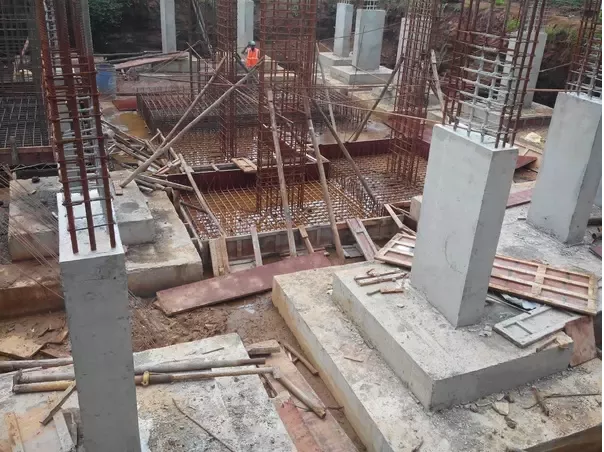It is not necessary to have Isolated Footings at all times and in all soil conditions.
Footings are designed to sustain the applied loads, moments and forces and the induced reactions and to ensure that any settlement which may occur is as nearly uniform as possible, and the safe bearing capacity of the soil is not exceeded. (IS 1904).
The type of footing chosen for a particular structure is affected by the following:
1. The bearing capacity of the underlying soil.
2. The magnitude of the column loads.
3. The position of the water table.
4. The depth of foundations of adjacent buildings.
Footings may be classified as deep or shallow. If the depth of the footing is equal to or greater than its width, it is called deep footing, otherwise, it is called shallow footing.
Isolated Footing is one of the Shallow Foundation. It is a circular, square or rectangular slab of uniform thickness. Sometimes, it is stepped/slopped to spread the load over a larger area. When footing is provided to support an individual column, it is called “isolated footing”.
Figure showing Isolated Footing.
It is not necessary to have Isolated Footings at all times and in all soil conditions. The major reasons for selecting the Isolated Footings are Economical when columns are placed at longer distances.
Ease of Constructability- Excavation, Form-work, Reinforcement placement and placing of Concrete is at ease. Workmen with little or no knowledge can easily construct an Isolated Footing.
Moreover, when the design rather soil doesn't demand Raft or Mat or another deep foundation, it is always suggested to proceed for Isolated Footing to save on cost.



![Different Applications of GIS [ Geographical Information System ]](https://blogger.googleusercontent.com/img/b/R29vZ2xl/AVvXsEhHuGl0hPEHKOfNPmTyBacOw3n4QQS54eRbfvEJfHxbOdImzfdroP0ab3tvCp98S2P8ZvJWqiz1clCwaQGVp2i9t9Nq4UkvRgcIR9X_chyphenhyphenkBJmhr4UIJRs4Jw0ppSn6jn56sVfBed4j9i7J/w100/8113229957_421c837a06_b.jpg)

![[PDF] Download IS 800 1984 | Civil Engineering Codes](https://blogger.googleusercontent.com/img/b/R29vZ2xl/AVvXsEiASJRvscBgyiE77vGXAXbgpreeQU2ym16bHBEVolAj6CciEV8R5BvsymmeXfRFc6xGoOe6KUN4_il3hx5F0jUPVA2cSUcxJynmhMDej21CbiYhi0VcyR-qgPRCXVAcv1oobWdG_nvoOW7S/w100/IS-800-1984.PNG)

![[PDF] SP 16 :1980 Design Aids For Reinforced Concrete to IS : 456-1978](https://blogger.googleusercontent.com/img/b/R29vZ2xl/AVvXsEj3vWyWR9sVpY2Mcip5F3ttq_4jje6Et0mqiBug-q8n7kClvXle3KD0XtZBwYBtmYFfIekvQYIW9gFB5aqcri6KrHD4x2PalOyEWAXPkLNFfbXe8m9m8WvCLSEWok7vPivvYidB1tj8JjeX/w100/is-sp-16-1980.JPG)
![[PDF] Download IS 800 Code | Indian Standard Code for Steel](https://blogger.googleusercontent.com/img/b/R29vZ2xl/AVvXsEjMmVdQd3q6sKYLbOG23DVJg2U_8IrdWJSfCcyA7gKs5NKVFBsi6dFPhGxoVctqzOHEIvJ6pqvQ6mpFMd5vV0U5IQHo-FETwRXTjbZ-Dok9CHxUJgePxHyFTHa2pNiWyW4mkYCJWOv_2IcP/w100/is-800-2007.JPG)
![[PDF] IS 456 2000 | Download Civil Engineering Code](https://blogger.googleusercontent.com/img/b/R29vZ2xl/AVvXsEjl8mzhZI_smGwhJPipCx2TuxHldgAvnHrYfkud8mDJ1kF4Syd83-TNKsXjyY1BVxFrxZ1tt-fErpupgiF146wqOfPtGo8M9GWrnQX9b9TyA-YtjlNWnlwdk9LaMN_JJN8AGCU619UI6Uu_/w100/is-456-2000.JPG)

0 Comments